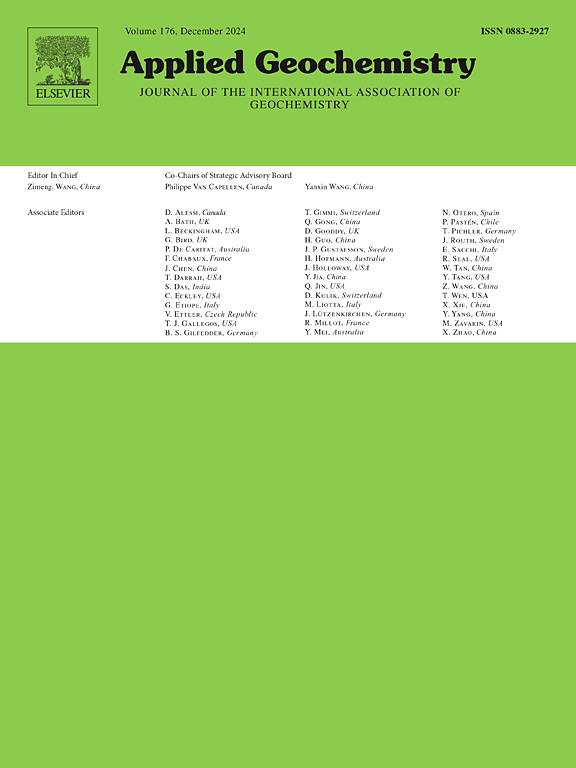蚯蚓是如何在人工有机-矿物系统中茁壮成长并驱动硅酸盐岩石风化的
IF 3.1
3区 地球科学
Q1 GEOCHEMISTRY & GEOPHYSICS
引用次数: 0
摘要
为了减缓大气中二氧化碳浓度的上升,增强硅酸盐风化正在成为一种潜在的重要的二氧化碳去除技术。然而,生物对岩石风化的控制还不是很清楚,特别是对关键的土壤动物群,如蚯蚓。蚯蚓已经显示出可能增强风化作用,突出了它们被引入可控或工程环境(如反应堆)以增加碳固存的潜力。在这里,我们确定了蚯蚓在模拟生物反应器的人工有机矿物系统中茁壮成长和增加风化率的潜力。我们使用了两种蚯蚓(Aporrectodea caliginosa [Savigny]和alloobophora chlorotica [Savigny]),以四种密度(10、20、25和30只蚯蚓kg - 1有机矿物混合物),四种硅酸盐岩石类型(两种玄玄岩、泥质岩和绿绿岩),两种颗粒大小(d50在0.026和1.536 mm之间),两种有机材料来源(秸秆和共消化物),两种量的生物炭(0和100 g kg - 1有机矿物混合物)和/或添加酶(上膜酶,尿素酶和碳酸酐酶分别为20、177和1955单位kg - 1有机矿物混合物),三种灌溉率(125、250和375毫升/天−1 kg - 1有机矿物混合物)和三种灌溉频率(1、2和5次/天−1)。实验分8轮进行,每轮持续8周,共为323个实验单位提供数据。我们测量了蚯蚓的生存和活动,以及有机矿物混合物和渗滤液中几种常用的风化指标,如总碱度、无机碳、pH、电导率和主要阳离子。通过随机森林回归分析,我们发现蚯蚓的生存和活动主要取决于影响有机-矿物混合物结构和排水潜力的变量,如秸秆的存在和粗粒度百分比的增加。此外,我们得出结论,蚯蚓对风化指标的影响取决于它们在实验结束时是否存活或死亡。存活的蚯蚓对风化指标的影响为中性或负面,这可能是因为实验时间太短,无法检测到无机碳的增加,或者是因为有机-矿物混合物中有机碳的增加而不是无机碳的增加。相比之下,死蚯蚓几乎增强了所有考虑的风化指标,这表明与蚯蚓尸体分解相关的微生物过程可能在增强风化中起作用。我们的研究结果还强调,如果风化指标完全依赖于矿物学和离子释放的变化来量化蚯蚓对风化过程中碳固存的影响,那么蚯蚓在生物反应器中增强硅酸盐风化中的作用可能被高估了。本文章由计算机程序翻译,如有差异,请以英文原文为准。
How earthworms thrive and drive silicate rock weathering in an artificial organo-mineral system
To slow the rise in atmospheric carbon dioxide concentrations, Enhanced Silicate Weathering is emerging as a potentially significant Carbon Dioxide Removal technology. However, the biotic controls on rock weathering are not well understood, particularly for key soil faunal groups such as earthworms. Earthworms have shown to possibly enhance weathering, highlighting their potential to be introduced in controlled or engineered settings, such as reactors, to increase carbon sequestration. Here, we determined the potential for earthworms to thrive and to increase weathering rates in an artificial organo-mineral system simulating a bioreactor. We used two earthworm species (Aporrectodea caliginosa [Savigny] and Allolobophora chlorotica [Savigny]) at four densities (10, 20, 25 and 30 earthworms kg−1 organo-mineral mixture), four silicate rock types (two basanites, dunite and diabase) of two to three grain sizes (d50 between 0.026 and 1.536 mm), two sources of organic materials (straw and co-digestate), two amounts of biochar (0 and 100 g kg−1 organo-mineral mixture) and/or enzyme additions (laccase, urease and carbonic anhydrase at 20, 177 and 1955 units kg−1 organo-mineral mixture, respectively), three water irrigation rates (125, 250 and 375 mL day−1 kg−1 organo-mineral mixture) and three watering frequencies (one, two and five times day−1). The experiment was conducted in eight rounds, each one lasting eight weeks, yielding data for a total of 323 experimental units. We measured earthworm survival and activity, as well as several commonly used weathering indicators in the organo-mineral mixture and in the leachate, as total alkalinity, inorganic carbon, pH, electrical conductivity and major cations. Using random forest regression, we found that earthworm survival and activity mainly depended on variables influencing the structure and drainage potential of the organo-mineral mixture, such as the presence of straw and increasing percentages of coarse grain sizes. Furthermore, we concluded that the effect of earthworms on weathering indicators depended on whether they survived or died by the end of the experimental period. Surviving earthworms had a neutral or negative effect on weathering indicators, likely because the experimental duration was too short to detect an increase in inorganic carbon, or because there was an increase in organic rather than inorganic carbon in the organo-mineral mixture. In contrast, dead earthworms enhanced almost all weathering indicators considered, suggesting that microbial processes associated with decomposing earthworm bodies may play a role in enhancing weathering. Our results also emphasize that the role of earthworms in Enhanced Silicate Weathering within bioreactors might be overestimated if weathering indicators exclusively rely on changes in mineralogy and ions release to quantify earthworm effects on carbon sequestration through weathering.
求助全文
通过发布文献求助,成功后即可免费获取论文全文。
去求助
来源期刊

Applied Geochemistry
地学-地球化学与地球物理
CiteScore
6.10
自引率
8.80%
发文量
272
审稿时长
65 days
期刊介绍:
Applied Geochemistry is an international journal devoted to publication of original research papers, rapid research communications and selected review papers in geochemistry and urban geochemistry which have some practical application to an aspect of human endeavour, such as the preservation of the environment, health, waste disposal and the search for resources. Papers on applications of inorganic, organic and isotope geochemistry and geochemical processes are therefore welcome provided they meet the main criterion. Spatial and temporal monitoring case studies are only of interest to our international readership if they present new ideas of broad application.
Topics covered include: (1) Environmental geochemistry (including natural and anthropogenic aspects, and protection and remediation strategies); (2) Hydrogeochemistry (surface and groundwater); (3) Medical (urban) geochemistry; (4) The search for energy resources (in particular unconventional oil and gas or emerging metal resources); (5) Energy exploitation (in particular geothermal energy and CCS); (6) Upgrading of energy and mineral resources where there is a direct geochemical application; and (7) Waste disposal, including nuclear waste disposal.
 求助内容:
求助内容: 应助结果提醒方式:
应助结果提醒方式:


